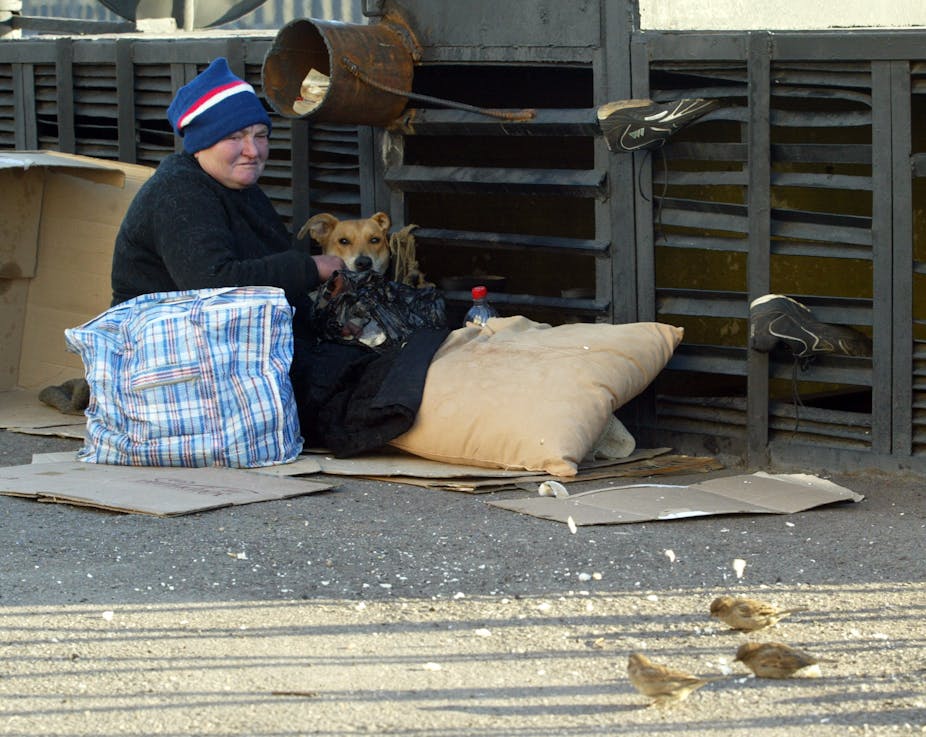Social services minister Kevin Andrews recently announced an extension of funding for the National Partnership Agreement on Homelessness (NPAH) until June 30, 2015. This agreement funds 180 homelessness services around Australia. The government will provide A$115 million – $44 million less than its predecessor – to extend the Commonwealth-state arrangement.
The government says it is not cutting funding to frontline services, only capital works. It is unfortunate that capital works are to be curbed at a time when more facilities are required to accommodate growing numbers of homeless. They include many people we do not automatically think of as being “at risk”. One such group is older women.
The Mercy Foundation has just released a report on how best to help this group, Older Women’s Pathways Out of Homelessness in Australia. In May, the issue of homeless older women will be a pivotal consideration in a report examining security of tenure for older Western Australians.
Such research reveals a troubling national trend: increasing numbers of women at or nearing retirement age are struggling to find affordable and secure housing.
Why are older women now at risk?
As with the general homeless population, homelessness among older women cannot be singularly explained. The group is diverse in age, education, location, cultural background and life circumstances. Homelessness can be triggered by a single, traumatic event or a lifetime of personal disadvantage and misfortune.
So what circumstances can lead to homelessness at an age when most expect “grandmothers” to be ensconced within the family unit? Beyond the pervasive issue of domestic violence, if there is insufficient superannuation, a partner dies, a marriage breaks down later in life or something goes wrong from a health or financial perspective, many older women find themselves in difficult circumstances.
Researcher Ludo McFerran argues that the entrenched social and economic disparity that women face places them at risk of homelessness. Changes in the life expectancy of women, the lack of affordable housing, the rate of divorce and separation (and the resultant number of women living alone) have created a wave of homeless, older working women.
One particular driver of homelessness is persistent income inequality. Women tend to move in and out of the workforce (as a result of childcare responsibilities) while also earning less than men.
Another study points to the growing gap between pension incomes and rents as a primary reason for the increasing number of aged people (in particular women) seeking help from homelessness services. The release of Anglicare’s confronting assessment of rental affordability for low-income Australians underscores this trend. A lack of income makes finding, or maintaining, accommodation difficult. In Perth, for example, the average rental in the private market is $470 a week, as shown below.

Long waiting lists make it difficult for older people to move into public housing. Boarding houses present another barrier. These establishments are predominantly occupied by men and many women, particularly older women, feel vulnerable in such an environment.
Solution must include suitable housing
So what can be done? Homelessness services have identified, and are implementing, a range of solutions and service models. The continued NPAH funding will ensure these services survive.
However, it is also imperative that innovative approaches to housing the homeless are pursued and that more, not less, capital funding is made available. This is especially the case with this “new” group of women who, for the most part, do not fit society’s image of homelessness. The supply of public housing must be increased with a view to constructing more single accommodation options suitable for older women.
In Perth, women aged over 50 are the fastest-growing demographic among homeless people. St Bartholomew’s is constructing a hostel for homeless older women in inner suburban Perth. While the NPAH announcement will not affect funding for this project, a freeze on capital works funding will inevitably have an impact on similar innovations proposed by other homelessness services.
As welcome and necessary as larger-scale construction is, capital works funding need not be directed solely to new structures. Relatively minor renovations could cater for homeless older women – for example, by converting one public housing dwelling into several self-contained bedrooms with use of a common kitchen and lounge area. Such works are relatively inexpensive and provide the additional benefit of companionship and support.
The plight of older homeless women is another troubling by-product of Australia’s housing affordability problems coupled with an ageing population. Lifetimes of wage inequality and a continuing lack of housing affordability and availability make it a near-certainty that numbers of homeless older women will increase. Innovative, cost-effective housing options that cater for emerging groups of homeless must be developed.
Now is not the time to reduce capital spending on homelessness. Services provided by support agencies are invaluable but, at some point, there must be an adequate supply of appropriate roofs over people’s heads.

